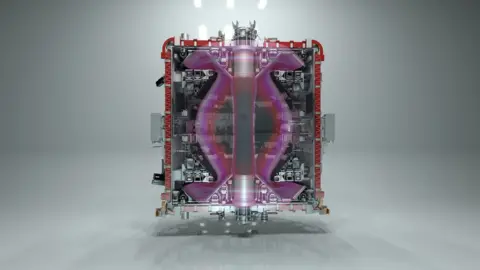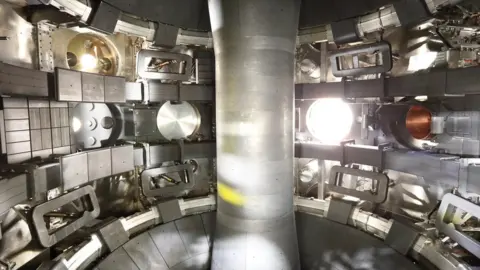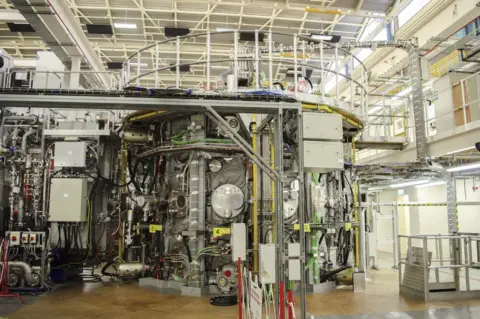UK fusion experiment used in hunt for clean energy
 UKAEA
UKAEAA pioneering nuclear fusion experiment based in Oxfordshire has been switched on for the first time.
Mast Upgrade could clear some of the hurdles to delivering clean, limitless energy for the grid.
Fusion differs from fission, the technology used by existing nuclear power plants, because it could release vast amounts of energy with little associated radioactivity.
The £55m machine has taken seven years to build.
Current nuclear energy relies on fission, where a heavy chemical element is split to produce lighter ones.
But nuclear fusion works by combining two light elements to make a heavier one. It's an attempt to replicate the processes of the Sun here on Earth.
Unlike fission, it produces no long-lived radioactive waste and could transform the way we source our power - tackling the climate crisis at the same time.
Mast (Mega Amp Spherical Tokamak) Upgrade will use an innovative design known as a spherical tokamak.
 John Lawrence
John LawrenceThe tokamak is a fusion device that uses magnetic fields to confine the plasma - hot, ionised gas - inside a vessel. This plasma allows the light elements to fuse and yield energy.
Most tokamaks are shaped like a doughnut. But in Mast Upgrade, the size of the doughnut's hole has been reduced as much as possible, giving the plasma an almost spherical profile.
Prof Ian Chapman, chief executive of the UK Atomic Energy Authority (UKAEA), said the switch-on was "a really momentous occasion".
The first plasma in the machine marks the start for this trailblazing effort to move the UK closer to building a fusion power plant. It's one thing to control a plasma and perform fusion. But it's another to generate more energy out of the reaction than the experiment puts in.
The Culham Centre for Fusion Energy is home to both Mast Upgrade and a fusion machine called JET (the Joint European Torus). JET uses the more conventional design, and was the precursor to a multi-billion-euro, international fusion machine called Iter. This latter project is one of the world's biggest science experiments, which will demonstrate fusion at scale.
In addition to the expensive fusion pathway being followed by Iter, researchers at Culham have been exploring a parallel track.
"We've been thinking about a pathway to fusion power plants which allowed for smaller, and therefore cheaper builds. That will hopefully allow quicker penetration into energy markets. That's the genesis behind the spherical tokamak," Prof Chapman told BBC News.
 UKAEA
UKAEABut, he says, "the big challenge behind the spherical tokamak is that the boundary conditions behind making fusion happen is that you need the fuel to be 10 times hotter than the Sun.
"If you put that into a much smaller box... the chances of melting the walls of the box are much higher. So you need a really clever way of getting the heat out."
What the engineers and physicists at Culham have done is design a complex and technically challenging exhaust system. UKAEA's scientists now plan to test this new exhaust, which is called the Super-X divertor, at Mast Upgrade.
It is designed to channel plasma out of the machine at temperatures low enough for the materials to withstand, meaning that components can last much longer.
"If it works, it really does offer a path to much more compact fusion power plants, in a much more cost-competitive way to delivering fusion here on Earth," said Ian Chapman.
UK Science Minister Amanda Solloway said: "We want the UK to be a world leader in fusion energy and to capitalise on its amazing potential as a clean energy source that could last for hundreds of years.
"Backed by £55m of government funding, powering up the Mast Upgrade Device is a landmark moment for this national fusion experiment and takes us another step closer towards our goal of building the UK's first fusion power plant by 2040."
Follow Paul on Twitter.
